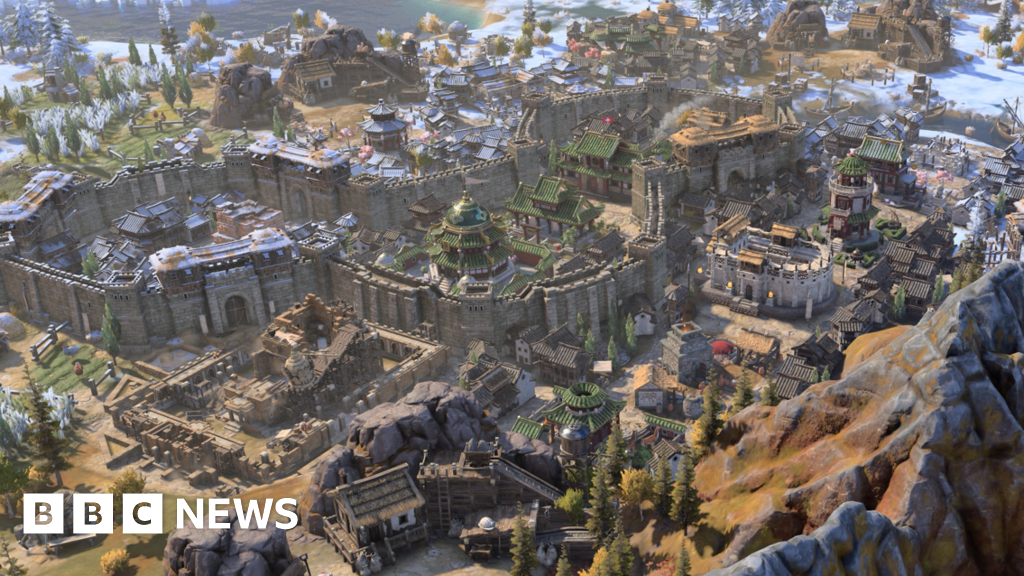 Firaxis
FiraxisFans of Civilization have been waiting almost a decade for the latest instalment of the cult video game series.
Now it has been revealed that theme of time passing is pretty appropriate: the inspiration at the heart of Civilization VII, to be released in February, is how the capital of the UK has changed from the Roman era to now.
And it all started with a map of Londinium – as London was known to the Romans.
“Londinium looked like pretty much any frontier Roman town with an amphitheatre, baths, and a shaky bridge that crossed to the south side of the Thames,” observed the game’s lead developer Ed Beach, as he showed me the below map – used here courtesy of Encyclopaedia Britannica.
“But I wanted to look at how this evolved, and how this changed as London grew and prospered.”
It is the lessons from those changes that will lie at the heart of the new game.
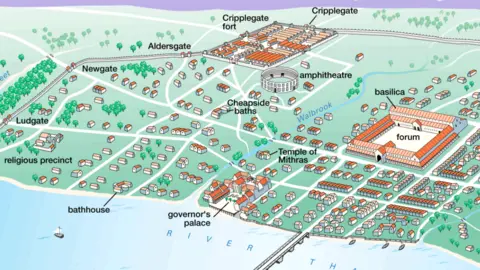 Encyclopaedia Britannica, Inc., 2004
Encyclopaedia Britannica, Inc., 2004The Civilization series has sold 70 million copies since it began in 1991 – with the last edition released in 2016.
The question of what direction developers Firaxis would take the next version of the game in has been a hot topic among fans.
I include myself in that group – my brother first introduced me to Civ II on our PlayStation back in the 90s, and I was recently slightly horrified to discover I’ve spent more than 500 hours playing the sixth iteration of the series.
For those that don’t know, Civilization is at times more like a board game than a video game. You move units around a map, placing down cities and developing them, while fighting others to conquer their land for your own.
Previous games in the series have locked players into playing as a particular leader and civilisation combination, such as Teddy Roosevelt and the United States, or Cleopatra and Egypt.
But the developers say this isn’t truly representative of how cities developed, where multiple different ruling groups leave their mark – just as they have with London.
In the new game, a player might start off as the Romans, building their own Londinium in what it calls the antiquity era.
But after progressing to the next stage – the exploration era in the game’s lingo – players might become the Normans and build over what came before.
The game’s developers drew inspiration from Ludgate, the site of the west gate in the former London Wall, and dug up more old maps to see how the area had changed 1,000 years after the Romans left London.
“London changes, and it grows, but you can see that core Roman encampment,” Mr Beach said.
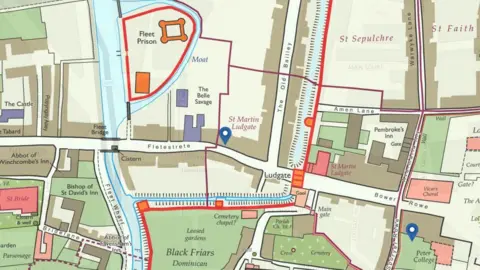 Layers of London
Layers of LondonThe map, produced by Layers of London, part of the UK’s Institute of Historical Research, shows the River Fleet still flows – but much of the Roman era buildings are no longer there.
“It’s all been built over by the buildings that you would expect in a medieval or renaissance era city,” Mr Beach said.
“We have inns, we have taverns, we still have religious buildings to the east side of the wall, but it’s now St Paul’s Cathedral, the very first version of it, before it got burned in the Fire of London.
“And we see that the river has been rerouted a little bit so that they can have a prison to hold some of those miscreants from the Middle Ages and keep them at bay.”
This difference formed the foundation of the new game – building on top of what came before, to craft distinctly different eras.
Finally, the developers jumped forward in time to the Victorian era, to see how the Ludgate area had changed once more.
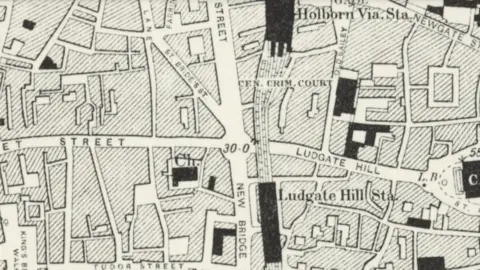 National Library of Scotland
National Library of ScotlandThis map, reproduced with the permission of the National Library of Scotland, shows another significant set of changes – with the River Fleet now no longer visible after it was rerouted underground to be used for sewage in the mid-1800s.
“Now the prison is totally replaced, the needs of the industrial revolution dictate we need a rail line in there, and Ludgate rail station is exactly on top of where the prison used to be,” Mr Beach said.
“All those buildings that used to support religious activity have pretty much been overtaken, except for St Paul’s Cathedral.”
This third stage of change – which the new game calls the modern era – solidified the concept for the developers.
In London’s example, gamers could play as the Romans, then the Normans, then as Britain – all the while building a growing England that goes beyond just the capital city.
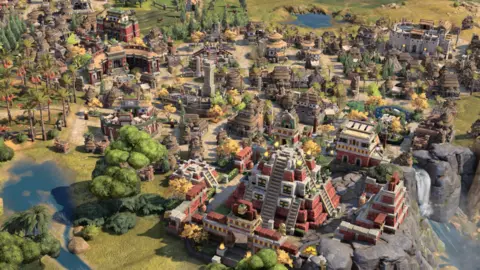 Firaxis
FiraxisWishlist of changes
But while the big shift in style may be exciting for some, hardcore fans of the series might be concerned about just how different it is.
It comes amid many other changes which will be meaningful to fans – though they won’t make too much sense to people who haven’t played the game.
The game’s developers tell me civilisations controlled by the computer will behave more intelligently. They list the seemingly endless changes like checking off a list – each civilisation has its own unique set of civics it can discover, units can now travel through rivers, and there are no more builders.
There are expected changes – like a graphical overhaul that makes the game look modern – and unexpected ones too – like shifting the leaders you play as to include important historical figures that didn’t lead their country, like Benjamin Franklin and Confucius.
Meanwhile Hatshepsut, one of Egypt’s historical female leaders, is now playable. The game’s narrator – Game of Thrones and Star Wars actress Gwendoline Christie – adds a layer of gravitas to the visual upgrade.
 Firaxis
FiraxisBut not everything was directly taken from a fan’s wishlist.
Roads will still be built automatically by traders, which has long been a sore point for some players. There are some changes to the game’s take on religion, but it still sounds to me like players will be micro-managing missionaries around the map.
And big promises of fixing the AI are well-received, but without seeing the final product it’s hard to be convinced.
Moving between ages seems to be linked to crises – like barbarian invasions, civil wars and plagues – though exactly how this will work is unclear.
Mr Beach said it develops a “cool cycle that you go through three times in the game that we’re releasing here at launch” – a sentence I told him sounded suspiciously like Firaxis might be considering adding further cycles and empires in the future.
He wouldn’t be drawn on it.
But one thing that seems certain is that by having what is effectively a big reset button between eras, no one player can storm ahead and take an unassailable lead at the start of each game, which will be music to fans’ ears.
We’ll find out when the game comes next year.

